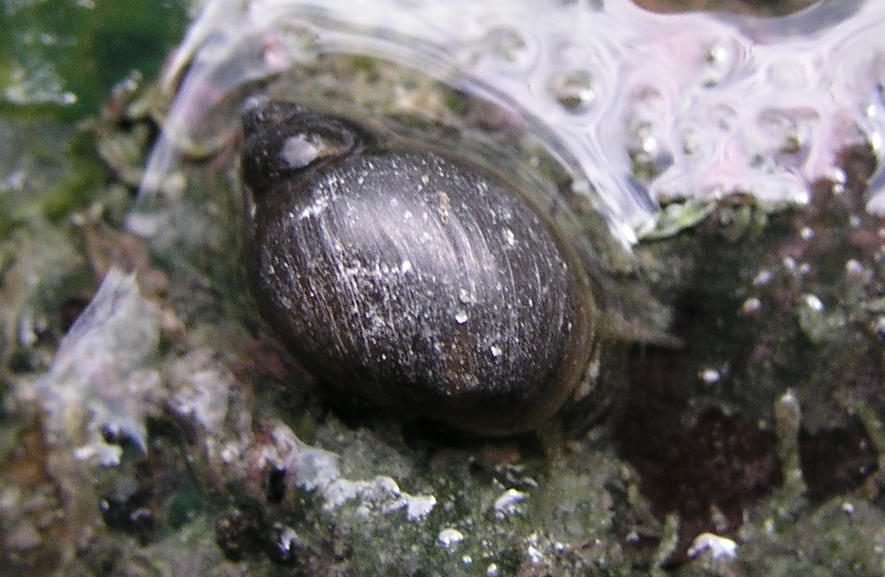- Banff Springs snail
Taxobox
name = Banff Springs snail

image_width = 225px
status = EN
regnum =Animal ia
phylum =Mollusca
classis =Gastropod a
ordo =Pulmonata
familia =Physidae
genus = "Physella "
species = "P. johnsoni"
binomial = "Physella johnsoni"
binomial_authority = (Clench, 1926)The Banff Springs snail, "Physella johnsoni", a small air-breathing freshwatersnail in the familyPhysidae .Distribution and conservation status
It lives in
Alberta in Canada and it was classified as endangered byCOSEWIC . The CanadianSpecies at Risk Act listed it in theList of Wildlife Species at Risk as being endangered in Canada. [COSEWIC. 2005. [http://www.sararegistry.gc.ca/virtual_sara/files/species/clwsa%5F0505%5Fe%2Epdf Canadian Species at Risk] . Committee on the Status of Endangered Wildlife in Canada. 64 pp., page 13.] In April 1997 it became the first livingmollusc to be placed on Canada's national list of species at risk.Fact|date=September 2008Description
The size of the snails are approximately the size of un-popped
corn kernels , which inhabithot spring water.The largest snails are only about one
centimetre long, and like all of the Physidae, the shells are sinistral or left-handed.Biotope
This species of
aquatic pulmonate gastropod mollusc is very unusual because it is adapted to life in an environment which is too harsh for most animals to survive in. The snails live inthermal springs where the water is low inoxygen and has a lot ofhydrogen sulfide .Conservation
Historically the snail was found in nine
thermal springs inBanff National Park ; however, since the 1920s, it can be found in only five of these locations, and unfortunately most of these five locations are high visitor use areas. Destruction and disturbance of the snail's habitat continue to threaten its survival; human actions such as illegal swimming, vandalism, garbage and coins thrown into the springs, all seriously disturb the springs' delicate ecosystems.Parks Canada is trying to protect the species through education, law enforcement, and scientific research. In 1996Parks Canada started a research and recovery program for the snail in an effort to protect it. The goals of the program are to maintain self-sustaining populations of the snail, re-establish populations at all historic locations, and hopefully to downlist the species' status.The snail population fluctuates seasonally. During times when the numbers are critically low, the snail is most vulnerable to human disturbances or natural disasters (like the spring temporarily drying up). While scientists don't know exactly why the population fluctuates so much, it is probably due to changes in water temperature and chemistry or changes to the bacteria and algae. It is estimated that the population varies between 1,500 and 15,000 snails. At its lowest points, the entire population of snails can fit in an ice cream cone, and at its highest, in a one litre milk carton.
Every four weeks researchers and volunteers count the snails and analyze the water chemistry. There is also a captive breeding program being performed, and if it is successful, the snails will be introduced back to the four additional springs where the species was historically present. Eggs are currently hatching in captivity; the time from laying to hatching is four to eight days.
Snails are not present at the
Banff Upper Hot Springs .Ecology
The snails' diet consists of "
Periphyton ".References
*cite journal |first=E.A. |last=Remigio |coauthors=Lepitzki, D.A.; Lee, J.S.; Hebert, P.D. |title=Molecular systematic relationships and evidence for a recent origin of the thermal spring endemic snails "Physella johnsoni" and "Physella wrighti" (Pulmonata: Physidae) |journal=Canadian Journal of Zoology |volume=79 |issue=11 |year=2001 |pages=1941–1950
External links
* [http://www.pc.gc.ca/regional/sourcesthermales-hotsprings/itm3-/natcul3_e.asp Parks Canada website]
* [http://www.mb.ec.gc.ca/nature/endspecies/sar/db08s23.en.html Environment Canada website]
Wikimedia Foundation. 2010.
